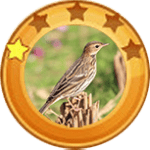- Home
- Shop
- Forest Series
- Grassland Series
- Desert Series
- Contact
- Home
- Shop
- Forest Series
- Grassland Series
- Desert Series
- Contact






LICENSED KIDS CAR GIFT
This 12V official-licensed upgraded kids ride on roadster with swing-up scissor doors is a realistic model of a Lamborghini Sain car, which will be an attractive Christmas/birthday gift for your 3-6 year-old toddlers to make them the eye-catching among their friends.
DURABLE STRUCTURE WITH SHOCK-ABSORBING WHEELS
Made from reinforced eco-friendly plastic (passed ASTM F963 and CPSIA), the motorized vehicle working on 4 wear-proof plastic wheels with comfortable spring suspension system is sturdy and stable for boys and girls within 55 lbs to explore the outdoors.
SAFETY DESIGN WITH 3-POINT BELT
Featuring a single seat with a 3-point safety belt, soft start/stop, limited speed (up to 3.1 mph), and remote priority function, the 12V toddler supercar is safe to play with parental supervision.


CHARACTERISTICS
The Chipmunk is a member of the family Mammalia, Rodentia and Sciuridae. It is also known as the Striped Squirrel, the Timber Tiger and the Mini-bear. The body length among most Chipmunks ranges from 5.5 to 6.3 inches and the tail length is 5 Inches. Chipmunks typically weigh about 0.02 pounds and live about 5 to 10 years. They have small but prominent ears which face forwards, and small eyes on the sides of their heads. Most wild Chipmunks are lively.


Lorem ipsum dolor sit amet, consectetur adipiscing elit. Ut elit tellus, luctus nec ullamcorper mattis, pulvinar dapibus leo.


CHARACTERISTICS
The Pechora Pipit is a small pipit, which somewhat resembles the non-breeding red-throated pipit. The species is heavily streaked brown above, with whitish mantle stripes, and with black markings on a white belly and buff breast below. It can be distinguished from red-throated by its heavier bill, whiter mantle stripes, and contrast between its buff breast and white belly.

RANGE AND HABITAT
The Pechora Pipit is a small passerine bird which breeds in the East Palearctic tundra and densely vegetated areas near river banks ranges from the Pechora River to the Chukchi Peninsula. It also breeds in Kamchatka and the Commander Islands.

DIET
Its diet mainly consists of insects.

BEHAVIOR
Often secretive and difficult to find. Usually walks around in dense grasses and is difficult to flush. Seldom calls even when flushed. This species creeps in long grass, and is reluctant to fly even when disturbed. Its call is a distinctive electrical zip. Although the call is generally helpful when identifying pipits, this species calls far less than most. This, combined with its skulking habits, makes this a difficult species to find and identify away from its breeding grounds in the Arctic.
The breeding habitat is damp tundra, open forest or marshland. The nest is on the ground, with four or five eggs being laid. This species is insectivorous, like its relatives. The breeding season takes place in late June/July in Siberia. The Pechora Pipit builds a cup-shaped nest with grass and leaves, and lined with softer material. This structure is placed on the ground, usually among low vegetation, or protected by low scrub or tuft of grass. The female lays 4-6 grey or green eggs with dark spots. She incubates alone during 12-13 days. Both adults feed the chicks during 12-14 days.

The Chipmunk is a member of the family Mammalia, Rodentia and Sciuridae. It is also known as the Striped Squirrel, the Timber Tiger and the Mini-bear. The body length among most Chipmunks ranges from 5.5 to 6.3 inches and the tail length is 5 inches. Chipmunks typically weigh about 0.02 pounds and live about 5 to 10 years. They have small but prominent ears which face forwards, small eyes on the sides of their heads. Most wild Chipmunks are lively.
The Red Squirrel, a member of the Sciuridae, is an arboreal, omnivorous rodent often referred to as a Forest Seeder and folklore as the Devil King Squirrel.
The Arizona Gray Squirrel, also known as the American Gray Squirrel, is a member of the family Rodentia and Sciuridae. It is small in size, with gray fur and a belly between white and cream. It has long ears, no tufts of fur and a fluffy tail edged in white. The body is about 16-20 inches long and weighs up to 1.4 pounds.
The Rock Squirrel, also known as Sao Maozi or Stone Mouse, belongs to the rodent and is a species in the family Sciuridae. The most common natural predators of the Rock Squirrel include bobcats, owls, eagles and snakes. Though the Rock Squirrel is cute, alert, and courageous, it is still considered a pest due to its habit of destroying crops.
The Abert’s Squirrel is a member of the genus Sciurus with a body length of 18-22.8 inches, a tail length of 7.5-9.8 inches and a weight of 2.2 pounds, and can live up to 10 years in the wild. Its most distinctive feature is tassels of fur about 0.8-1.2 inches long at the tip of its ears, which looks very interesting. In addition, it is alert and agile.

Day 168: The 3000th Bird
June 17, 2015, Adana, Turkey — At 9:00 this morning, near the top of Mount Nemrut, I snapped a photo of a Tawny Pipit, my 3,000th bird of the year. Just two thousand to go…and I haven’t even touched Africa, Asia, or Australia yet!
Nemrut’s 7,000-foot summit, which commands a panoramic view of southeast Turkey, helped put the “stone” in this milestone. During the first century B.C., a king named Antiochus was impressed enough with the view here that he commissioned a bunch of huge, Easter Island-like stone statues and had them laboriously carried to the top of the mountain.
The statues, which depict a variety of recognizable gods, still stand more than 2,000 years later, a little worn and cracked, gazing over the country. Archaeologists think Antiochus’s tomb must be nearby somewhere, too, but haven’t dug around enough to find it yet. Red-tailed Wheatears and White-winged Snowfinches flitted among the rocks.
It’s an incredible spot, and if this place were, say, in South America, it would be jammed with tourists. Except for a park guard and a bored-looking guy selling souvenirs, though, we had Mount Nemrut to ourselves all morning. General tourism in southern Turkey has taken a hit lately with Syria in the news (especially this week) even though there have been few security issues on the Turkish side of the border. In the past couple of days I have birded within about 30 miles of ISIS-controlled territory; at one point Emin pointed out several tents by the road and said they were Syrian refugees, but otherwise I’ve seen no signs at all of the conflict. It was strange to be next to one of the world’s current headline hotspots yet still so very far away.
My four days in Turkey came to a close this evening. Emin and I celebrated with kebabs (a particular Adana specialty) for dinner. He has been a wonderfully enthusiastic birding companion for this segment. (If you ever visit Turkey, he’d be happy to help guide your trip: [email protected].) Meanwhile, on to Spain tomorrow!



Follow Us: